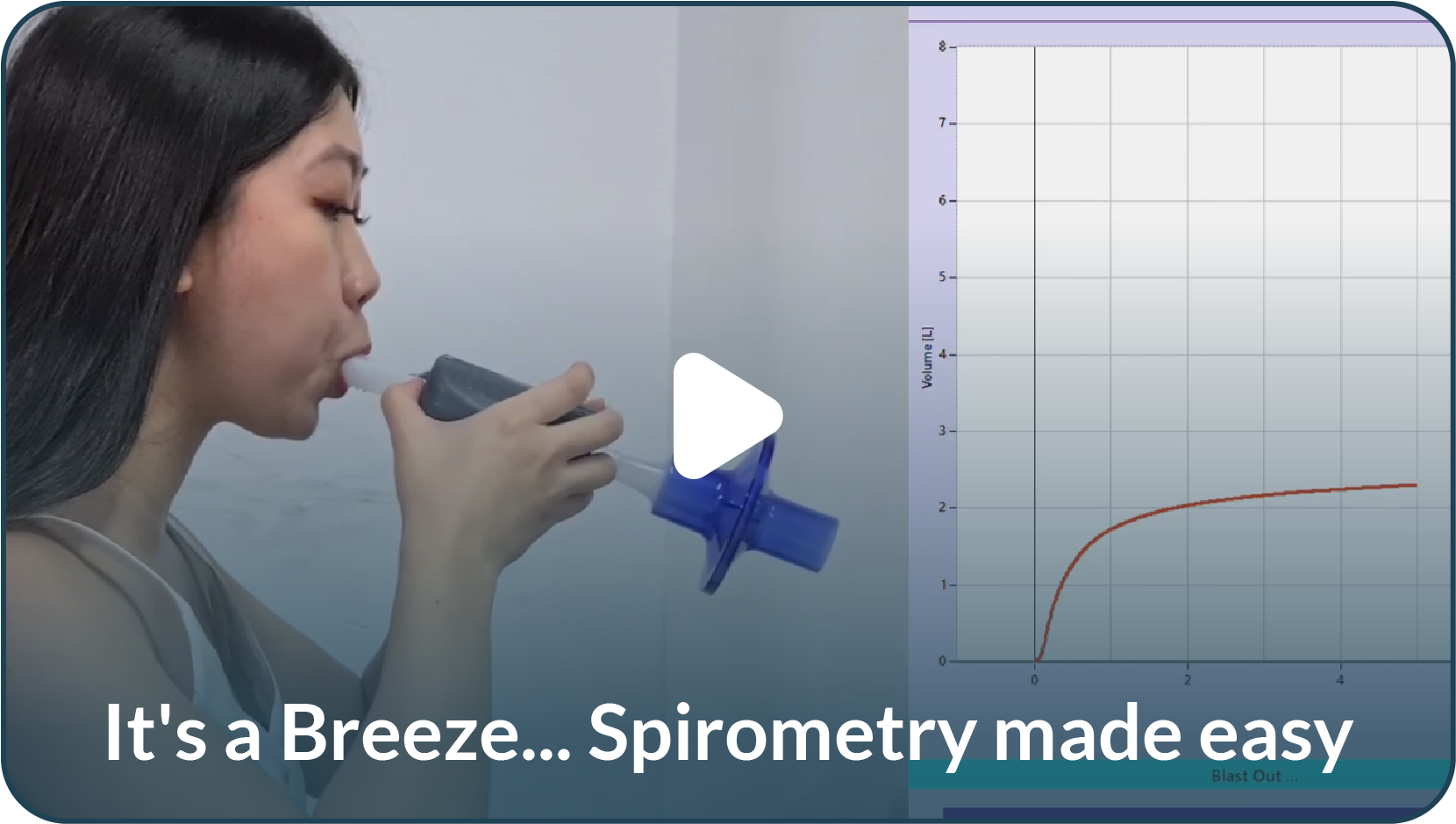What is Spirometry?
Spirometry is a common lung function test that measures airflow in and out of your lungs. It is often done to help diagnose and differentiate between different lung conditions like asthma and COPD. In fact, spirometry is considered the "gold standard" for the diagnosis of COPD.3
Spirometry can also help to detect early COPD, even before symptoms start to occur.7 As COPD is a progressive condition, diagnosing it early can help you to take necessary action to prevent further worsening of the disease.
Your doctor may also order a spirometry test to assess how well your lung condition is being managed, and whether your current treatment is sufficient.3
What happens during Spirometry?
Spirometry is typically conducted in the clinic or hospital. However, mobile spirometry services such as Spirometry-At-Home (SAH) are also available. Each test may take around 20 to 45 minutes to complete.
These are the general steps involved in a spirometry test8:
- Sit upright in a chair. A clip may be placed on your nose to keep both of your nostrils closed.
- You will be given a plastic mouthpiece or a breathing mask, which is connected to a machine known as the spirometer. This spirometer will measure the amount and speed of airflow in and out of your lungs.
- Ensure a tight seal between your lips and the plastic mouthpiece.
- Inhale as deeply as possible. Once you have reached maximal inhalation, forcefully exhale as hard and fast as you can through the mouthpiece.
- Steps 3 & 4 may be repeated a few times to ensure consistent results. You may be asked to rest in between each repeat test to ensure that you are able to exhale with your usual maximal effort.
You may also be asked to repeat the test after inhaling a bronchodilator medicine that helps to open up your airways. This is done to see if your breathing improves with the medicine.
Your doctor will subsequently interpret your spirometry results and schedule a follow-up consultation with you to explain the findings.

How do I prepare for a spirometry test?
The spirometry test is non-invasive and painless. Doing the following can help to ensure your test is as accurate as possible3:
- Wear loose, comfortable clothing that will not restrict your breathing
- Avoid smoking before the test
- Avoid any heavy meals or intense physical exercise immediately before the test that may affect your breathing
- Get a good night’s sleep as tiredness may affect the accuracy of the test
You may be instructed by your doctor to hold off on using some inhaler medications for a few hours before the test. If unsure, contact your doctor to confirm the instructions.
Spirometry-at-Home
While spirometry has typically been done in the medical setting, there is increasing use of spirometry-at-home (SAH) since the COVID-19 pandemic.9 Your doctor may order a spirometry to be done in the isolation and comfort of your own home, which may be more convenient, comfortable, and have a lower risk of spreading airborne germs.
If you think that this service may be useful for you, speak to your doctor. You may find out more about mobile spirometry services by contacting us at contactus@copdas.com for any queries.
- Diab N, et al. Am J Respir Crit Care Med 2018;198:1130–1139.
- Global Initiative for Chronic Obstructive Lung Disease (GOLD) Patients and Advocacy Groups. Available at: https://goldcopd.org/patients-advocacy-groups/. Accessed on 1 July 2024
- Global Initiative for Chronic Obstructive Lung Disease (GOLD). Global strategy for the diagnosis, management, and prevention of COPD 2024 report. Available at: https://goldcopd.org/2024-gold-report/. Accessed on 14 November 2024
- Fletcher C, et al. Br Med J. 1977 Jun 25;1(6077):1645-8.
- Agusti A, et al. Lancet Respir Med. 2019 Apr;7(4):358-364.
- Melén E, et al. Lancet. 2024;403(10435):1494-1503.
- Choi JY, et al.. J Clin Med. 2020 Oct 26;9(11):3426.
- Healthline. What to Know About a Spirometry Test. Available at: https://www.healthline.com/health/spirometry. Accessed on 10 July 2024.
- Saunders MJ, et al. Chest. 2021 Oct;160(4):1241-1244.
- World Health Organisation (WHO). Chronic obstructive pulmonary disease (COPD). Available at: https://www.who.int/news-room/fact-sheets/detail/chronic-obstructive-pulmonary-disease-(copd). Accessed on 30 May 2024.
- Piquet J, et al. Eur Respir J. 2013;42(4):946-955.
- Ho T-W, et al. PLoS One. 2014;9(12):e114866
- Donaldson GC, et al. Chest. 2010;137(5):1091-1097.
- Lareau S, et al. Am J Respir Crit Care Med. 2018;198:21-22
- U.S Centres for Disease Control and Prevention (CDC). Smoking and Tobacco Use; Benefits of Quitting Smoking. Available at: https://www.cdc.gov/tobacco/about/benefits-of-quitting.html. Accessed on 1 June 2024.




